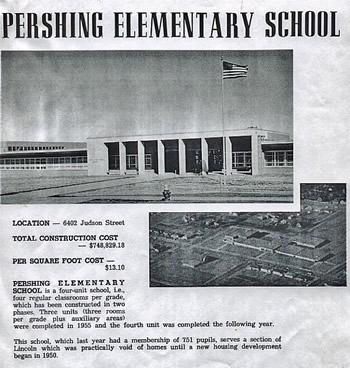PER – Pershing Elementary
- LOCATION: 6402 Judson St, 68507
- OPERATION: 1955 – Present
- Web site
Pershing was named for General John J. Pershing (1860- 1948), commander of the American Expeditionary Force (AEF) in Europe during World War I. He was named General of Armies by a special act of Congress, one rank above the five-star generals of World War I. Although Pershing was not a native of Lincoln, he fell in love with the city while serving as commander of cadets at the University of Nebraska in the 1890’s. He adopted Lincoln as his hometown but was seldom in residence here.
Photo provided on Pershing’s web site.
Additional History
The following information is collected from an editorial column presented in the Lincoln Journal Star in July 2023.
Lempke, Major General (retired) Roger P. “Local View: Why Pershing matters.” Lincoln Journal Star [Lincoln, NE], 14 July 2023, Editorial sec., p. A6. Lincoln Journal Star, journalstar.com/opinion/columnists/local-view-why-pershing-matters/article_75202640-1cf7-11ee-b8a7-6bb0feef4292.html. Accessed 14 July 2023.
Military Service
Lieutenant John J. Pershing graduated from West Point in 1886 during the same period when his family moved to Lincoln.
He asked for the assignment to the university and made an indelible imprint on the University of Nebraska during his time as a professor of military science beginning in 1891. He is locally famous for forming the Varsity Rifles, which eventually became a national organization known as the Pershing Rifles. He also earned the law degree that he had dreamed of getting before going to West Point.
After leaving Nebraska, he commanded the 10th Cavalry Regiment (among the first Buffalo Soldiers regiments) consisting of African-American soldiers led by white officers, a unique assignment at that time. His next assignment at West Point as a tactical instructor earned him the nickname “Black Jack” Pershing, which would be his forever tagline.
His life became turbulent after leaving Nebraska. After the West Point assignment, he served in different capacities as an observer in the Russo-Japanese War and the Balkans, a military attaché in Tokyo and a commander in the Philippines.
He led forces during the Spanish-American War and the Pancho Villa Expedition into Mexico. His life changed dramatically when his wife and daughters were killed in a house fire in 1915 while he was leading troops in Mexico.
Pershing retained his connection with Lincoln over the years. His sisters lived in Lincoln, he owned property here and he even thought about retiring to Lincoln.
General of the Armies John J. Pershing retired from military service in 1924. Upon his retirement from military service in 1924, he was called to serve in many different leadership capacities until his death on July 15, 1948.
Naming of Local Facilities after Gen. Pershing
The need for a modern auditorium in Lincoln became apparent in the 1930s. Unfortunately, the Great Depression and World War II delayed the beginning of a new auditorium and construction of the Pershing Auditorium did not begin until 1955, after World War II. During this period plans were underway to build a new high school in the northeast section of the city. Prospective students voted to name the school after retired Gen. John J. Pershing. However, the city of Lincoln had already decided to name its new auditorium after Pershing. Following local protocol, the new school was named Lincoln Northeast High School when it opened in 1941. Also taking the Pershing name during this period was newly constructed Pershing Elementary School in 1955. After some contentious issues, construction of the city auditorium finally began in 1955, and it opened in 1957 as the Pershing Municipal Auditorium.
The Pershing Mural
Pershing Municipal Auditorium included a 38-by-140-foot mural depicting life in Nebraska, which became well known throughout the region. The auditorium was in service to the community and region from 1957 through its closing in 2014, after which community efforts raised money to properly remove and restore the mural. Removal and restoration was successfully completed in 2023. Current plans intend to install the mural within historic Wyuka Park.

